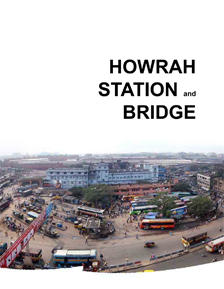Howrah Station and Howrah Bridge
at the epicenter of traffic, a train-station as a universe

Students: Mira Habermann, Andrea Pozzoli
Location: Group work in Kolkata
Date: November, 2008
Type: Research project, student work, Howrah Station and Howrah Bridge
Background
Kolkata offers a complete range of transport modes for a contemporary city: It is one of the last cities in the world still operating handpulled rickshaws; it offers bicycle rickshaws, auto rickshaws and an enormous fleet of yellow painted taxis. The city is crisscrossed by numerous bus lines and even trams, being the only Indian city having this very European mode of transport. In the eighties, Kolkata was the first Indian city to construct an underground line (a tremendous achievement in the muddy grounds below the city) and the metropolitan area is served by numerous suburban and long-distance trains. Howrah Station can be considered to be the epicenter of all Kolkatan traffic, its ‘eye of the storm.’ Howrah Station is Kolkata’s main train station, but is located on the ‘other’ side of the Hooghly river, connected to the city of Kolkata via the Howrah bridge. The current building being built in the very beginning of the 20th century with 13 platform tracks, it can be traced back to the 1850s when the first track was laid connecting then Calcutta with the coalfields of Bardhaman. Having been extended by additional 8 platform tracks in the 1980s, is has since become one of the largest and busiest train stations in the world with more than two million passengers passing through the station every day.
Themes
Howrah Station encompasses hotels, police stations, shops, restaurants. It offers various services such as internet cafes, telephone booths, photographs or medical services. It is also a place exhibiting the ‘dark sides’ of urban life being home to a resident population of orphans or children that have run away from home, a place of drug use, prostitution and criminal activities. Howrah Station can be seen as a self-contained city. Its more than two million passengers daily compare favorably to most population sizes of the biggest European cities. Also on a spatial level, especially after the projected extension of an additional 15 tracks to a total of 37 platform tracks, turn Howrah Station into an urban entity in its own right, a train-station as a universe.
Project
Represent Howrah Station as a self-contained city. What are the activities that are being pursued in the station? Who uses what kind of spaces? How does the negotiation of spaces work? What is a typical day in the life of Howrah Station? What is the range of activities, services and spaces that are available in the station? Document the spaces and modes of traffic with Howrah station as the epicenter. What is the ‘architecture’ of each traffic mode? What distances, social groups, areas and speeds are covered by each mode? Is there a traffic masterplan for the Kolkata Metropolitan Region? What are the guiding principles?
Download the Book PDF

